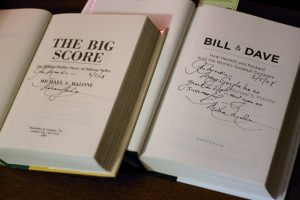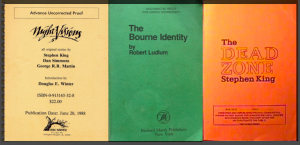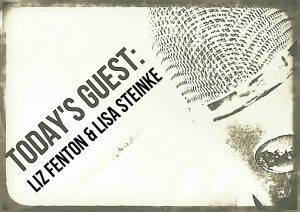Publicity
Let’s talk about your authorial autograph. You’re gonna sign a lot of books on your way to the bestseller list. But you can’t just sign your name like you do on personal checks and contracts, unless you want to be picking up a lot of your readers’ bar tabs. (If I catch you doing this, I’ll personally steal your identity just to teach you a lesson. I am strict but fair.) All your favorite authors have practiced their book-signing signature for years. You would be surprised by how many authors landed multi-book deals just because their signature looked cool. (It’s like five or six, which is still a lot for this sort of thing.) I’m here to share their signature moves.
Choose Your Weapon
Choosing the correct pen is half the battle, or at the very least, provides a great excuse to go to the office supply store. Sharpies are terrific for this. Make your signature stand out by choosing a color other than black. To really have some fun, sign your name in invisible ink, especially if the person you’re signing it for is giving the book as a gift. Ha ha, what fun!
Pen color isn’t all that important, though. Like a camera, the best pen is the one you have with you. And if you don’t have a pen with you, you’ll have to sign in blood, which is dangerous–more than a few authors have accidentally sold their souls to the devil this way. For that, you’ll want to hold out for at least six figures.
Where were we? Right, pens. Very, very important.
Practice Makes Perfect
Method 1: The Squiggle
The ink should flow from your pen like the wine flowed down your gullet when you wrote your book. I don’t mean that literally–we don’t want the pen to explode, you lush! Just put some oomph into it while you’re signing. If you do it right, your signature should match your polygraph readout when someone asks you how many books you’ve sold.
Read MoreAt the risk of making everybody’s eyes glaze over, today I’d like to talk a bit about one of those hands-on, practical issues that’s key to any book’s life cycle but totally unsexy: Galleys.
No, this has nothing to do with seafaring or food.
The truth is, there’s a lot about writing and publishing that’s not only unsexy but – as my French husband likes to say about certain other things – real “love killers.” (Picture husband sneering at my comfy fleece PJs and saying, “un vrai tue-l’amour.”)
But like with those PJ’s, we’ve just got to have them. Editing, revisions, production timelines, marketing, sales reports…. These are just as important to your book as those sexy, dazzlingly inspired late-night write-athons we’d all much rather be talking about.
Galleys are one of these things. While we’d love to ignore them and just keep writing, if we do they’ll eventually get in our way. (Just like those PJs…) Because at some point, most authors publishing and publicizing a book will need to understand galleys and make decisions that involve them. Otherwise, vetting your book and getting it the visibility it deserves becomes extremely complicated. I’ve seen this happen all too often.
Many of you have probably already heard the word “galleys” floating around in writerly circles. But I’ll bet that you’re not exactly sure what it means. So let’s start with their definition.
In essence, galleys – which are typically created up to 5 months or so before your pub date – are a preliminary version of your book used by your publisher for various purposes before the final copy is ready. Sometimes called “galley proofs” or “uncorrected galley proofs,” they might still have typos or even sections that need some tweaking. Often the cover has not been designed yet, and instead, is a temporary layout showing basic info such as the title, the publisher’s name, your name and the publication date. Or the cover might be partially designed so that the front is in pretty good shape but the back has a lot of space left to fill. That’s where, ultimately, blurbs should go.
Yes, they’re usually ugly. Like fleece PJs. But like the PJ’s, they’re also practical. Beauty aside, there’s a lot they’ll be used for:
What if, like so many authors nowadays, you’re with a small press that doesn’t produce galleys at all? Or are self published?
Read MoreHappy authors, happy audience: at an Eagle Books launch earlier this year
As co-director of a small press publisher, Christmas Press, and its associated imprints, Eagle Books and Second Look, November is a busy month for me. We have three book events scheduled, two being a launch for the same new book on two different days in two different cities and the other being a re-celebration, in a different city, of a book published (and launched) earlier this year. In the weeks and months leading up to the events, I nailed down the details; venues, publicity, making sure authors can come, and ensuring that the books would be available at the various venues. This is easy when it’s being held in a bookshop, as one event is, but not so simple when they are held in other places. It’s certainly not the first time that I’ve run such events, both as publisher and as author, and it’s pleasing to know that they have generally been very successful. It struck me that perhaps WU readers might be interested in some of my tips on planning book events.
If it’s a launch, think carefully. I know most of us authors love a good book launch but not every book needs to be launched—and wearing my publisher hat, I understand why publishers can be reticent about that! For a start, it’s a lot of work, it costs money, and your supporters can get launch fatigue if you do launches too often. Launches are especially good for debut books; for bespoke, collectible books; and for group books, such as anthologies and collections. In each of those three cases you are pretty much guaranteed to get a good crowd, as friends and family flock to the debut author’s event, connoisseurs and special-interest people get fired up over owning their own signed copy of a collectible book, and contributors to anthologies and collections can be relied on to turn up to celebrate their group effort, bringing their own supporters with them. Don’t get me wrong: I’m not saying that other types of book launches don’t work. They certainly can, but you’ll need to put in extra work and imagination if the launch is for say your fifth or tenth or twentieth book—unless of course you are a bestselling author for whom crowds will always come no matter what!
Read MoreWarning: Hacks for Hacks tips may have harmful side effects on your writing career, and should not be used by minors, adults, writers, poets, scribes, scriveners, journalists, or anybody.
Being on a panel at a conference or convention is the most exhilarating experience a writer can have. Simply nothing beats the feeling of having people treat you like an interesting, attractive, knowledgeable expert. Well, except money and fame, but don’t hold your breath for those, pal. I mean, come on!
If it’s your first time on a panel, it’s your job to make sure the audience isn’t bored. You can learn how to give good panel by following my easy advice.
What to Bring
What to Wear
When approached by self-published authors for help with book promotion, I used to ask a single question:
“Do you have blurbs from at least two established authors?”
If the answer was no, I’d suggest they gather some before we speak. Blurbs are an essential piece of the vetting process and vetting is crucial to gaining the media’s interest. All the more so for self-published books, which don’t have the benefit of a publishing house’s stamp of approval.
While I still request blurbs, I’m beginning to think there’s another question I should ask self-published authors considering a PR campaign:
“Did you query literary agents for at least six months before deciding to self-publish?”
From down here in the PR trenches, this has nothing to do with whether an author opting to self publish tried to get a traditional publishing deal or how that went. It makes little difference to me whether somebody “almost” had an agent, got glowing rejection letters or received dozens of full manuscript requests. I’m not looking at agent interaction as a form of validation, since in the end, the only real form of validation from an agent is a contract.
Rather, the experience of querying agents provides crucial preparation for the experience of book promotion.
As we all know, the process of querying is charged with hope and expectation, trepidation and angst. Each query letter contains a piece of our heart; each inevitable rejection letter — or lack of response — breaks our heart in its entirety. The waiting and uncertainty break our spirit. Yet from these wounds grow the emotional armor we need to keep at it, the patience and resilience that allow us to shrug in the face of prolonged uncertainty and above all, the deep humility that is fundamental to every writer’s survival, and success.
It may come as a surprise, but the experience of book promotion has a lot in common with the querying journey. Your publicist is, in essence, querying reporters and reviewers on your behalf. With the market for book news and reviews just as crowded and competitive as the literary marketplace itself, your publicist will be getting far more rejections than hits. In fact she or he may send out hundreds upon hundreds of email pitches and many dozens of hard copies of your book to yield but a tiny handful of news items.
Read MoreThe free book is a delightful and welcome creature. Even more delightful is the Advance Review Copy or ARC, also called a galley. These are, as the name suggests, advance copies of books – available months before the finished book goes on sale, intended for the purpose of review. Book bloggers can often get their hands on ARCs by emailing the publicity department at a publishing house, requesting them through a system like Edelweiss or NetGalley, winning them on Goodreads, or by attending trade shows such as BookExpo America.
But there’s an etiquette around ARCs, and like so many things in the publishing industry, it isn’t always clearly spelled out in writing. So here are some key do’s and don’ts to keep in mind when you find yourself in possession of an ARC.
DO: write an online review. This is the entire intent of ARCs, and just keeping a free book for yourself is not the point. Free is fun, sure, but publishers produce them for a reason, and the reason is not to shore up a leaning coffee table or give you something to read at the pool that you don’t mind damaging with water and smears of sunscreen. All you’re obligated to do – just one thing – is to write a review. Which brings us to…
DON’T: feel obligated to write a glowing review just because the book was free. Sure, that’s what we’d all prefer (speaking as an author here!), but it’s not a requirement. The requirement is for an honest review, not a positive one. If you don’t like the book, you’re within your rights to say so – just be sure you explain why. Professional reviewers don’t fulfill their obligations with a one-star “HATED IT” on Amazon, nor does any responsible reviewer, paid or unpaid.
Read More
The question of how important book promotion is to sales and an author’s career is the subject of continual, heated debate.
On one hand, many agents these days urge their clients to hire an outside publicist no matter who their publisher is, claiming that without robust PR and promotion no book (or author) has a future. On the other hand, many — like WU’s own Donald Maass — stress the greater importance of staying focused on writing, insisting that the real ticket to sales is to craft a killer book. Combined with the fact that the level of efforts publishers make varies wildly and publishers’ in-house teams often shrug indifferently when authors ask if it’s worth hiring help, this makes for a lot of mixed messages, ambivalence and confusion.
Add to that the unclear correlation between promo efforts and sales and the entire issue starts to look like a riddle that’s impossible to solve.
Over the years, though, I’ve noticed one surprising pattern that might offer an answer for many:
When successfully implemented BEFORE a manuscript is even shopped around, book PR can have quite a profound impact, one that will ripple out well into the future.
I know, you’re probably thinking, “Huh? Has she lost her mind?” After all, how can you promote a book while in essence it’s still a work-in-progress?
While it’s true that at such an early phase you can’t promote a book per se, what you can do is promote yourself: your name, your background, your voice and your ideas. As the author, you are the persona behind your work. Thus promoting the book and promoting yourself are one in the same.
Authors who promote themselves in advance of searching for an agent or simply find themselves in the fortuitous position of having an existing media platform enjoy a number of distinct advantages when it comes time to shop that manuscript:
Read MorePlease welcome return guest Martha Conway! Martha’s first novel was nominated for an Edgar Award, and her novel Thieving Forest won the North American Book Award for Historical Fiction. Her short fiction has been published in the Iowa Review, Carolina Quarterly, Folio, and other journals, and she teaches creative writing for Stanford University’s Online Writers Studio and UC Berkeley Extension. Martha grew up in northern Ohio and now lives in San Francisco. Her latest novel is Sugarland.
I love libraries, and I was excited when a number of librarians in Ohio asked me if I would hold a reading at their library. Later I realized that my library tour had some advantages over a traditional bookstore tour, which I thought other authors might want to know about.
Connect with Martha on Facebook and Twitter.
Are Libraries the New Bookstores?
Last year I was about halfway through my book tour in Ohio when I noticed something strange: I had not yet laid eyes on a bookstore.
I was traveling with my father and my sister through northwest Ohio. My novel Thieving Forest, which prompted the tour, took place in this area in 1806, when it was known as the Great Black Swamp. Today the swamp is mostly drained except for a few state parks and forests, and what has taken its place is farmland. Miles and miles of farmland.
“Hey, have you noticed there are no bookstores anywhere?” I asked my sister.
She said, “But there are a lot of libraries.”
That was a good thing, since I was on a book tour of libraries—eight of them. Every reading I held except for one (there’s always one) was extremely well attended with an audience full of avid readers. They had interesting questions, insightful comments, and we always engaged in a lively discussion. It was every writer’s dream. And then, after each reading, my sister and I sold my books—at a discount, since there wasn’t a bookstore’s cut to consider. The readers were happy and I was happy, too.
It turns out that just because there were no bookstores didn’t mean there were no readers. They were all at the libraries.
I love bookstores, but I have an even deeper attachment to libraries that began in childhood. Like most compulsive readers, my branch library was my second home. After I read From the Mixed up Files of Mrs. Basil E. Frankweiler, I fantasized about running away like the two siblings in the book, only instead of living in a museum as these characters had, I wanted to live in my library.
Read MoreWarning: Hacks for Hacks tips may have harmful side effects on your writing career, and should not be used by minors, adults, writers, poets, scribes, scriveners, journalists, or anybody.
You’ve tried everything—publishing, self-publishing, vanity publishing, e-publishing, third-person publishing—but you just can’t achieve the breakthrough success you’ve always desired. No mere mortal can climb Slush Mountain of their own accord; you must become something more. You must encase yourself in a foolscap chrysalis and emerge even better than your best self. You must summon all your creative power, all your skill, all your life experience to give life to—then take it from—the greatest literary mind of the twenty-first century: yourself.
Stage 1: Create Your Ideal Author
The first thing you’ll have to do is create a pen name. What, you thought you were gonna get to keep the loser name you’ve done nothing with? Names are important, which is why you must ditch that anchor of a moniker that’s been weighing you down your whole career. Imbue your new persona with every virtue you wish you had for yourself–not just talent, but good looks, charm, a spotless criminal history. You’re not creating a Mary Sue, you’re creating a Virgin Mary Sue who will give birth to the salvation of your literary dreams.
Stage 2: Logistics
Stage 3: Murder Your Darling
Now that you’ve created this literary monster, it’s time to unlife them. This should be easy; ever since you read Game of Thrones, you’ve taken a fiendish delight in butchering your characters in your books. Yet this feels different, does it not? More personal, like one of those spy movies where the hero has to kill a rival agent who is also their lover. Just be kind and make Your Ideal Author’s death a quick one. And glorious, like a train derailment off a mountainside or something. Just like your mermaid samurai in your sci-fi epic came to learn, being a hero means making sacrifices. Except you don’t feel like the hero, do you? Your Ideal Writer was far more heroic, more noble than you could ever…well, never mind that, now. In time, you’ll learn to forgive yourself for what you’ve done
Read More
“What can I do to get my book onto a bestseller list?”
If I had a dime for each time an author has asked me this question, I wouldn’t need to be a bestseller myself to be rich. Until recently though, my answer has always been a disappointing, “I have no idea.” Or, “There’s nothing anyone can do.”
Then I had a fascinating conversation with the team over at Greenleaf Book Group, an independent publisher and book distributor. Greenleaf not only helps develop ideas into books which they then publish, promote and distribute they also also work with qualifying authors to make that bestseller list dream come true. And they’re successful at it.
What I learned was so eye-opening that I’ve invited Greenleaf marketing associate Magdalene Thomas to talk with me about strategies for reaching those bestseller lists in a Q&A here on Writer Unboxed. Magdalene’s work planning and executing strategic marketing campaigns with independent authors has resulted in numerous bestseller placements.
Welcome, Magdalene. Let’s dive in!
SB: When I heard that there are actually steps authors can take to help their books hit bestseller lists, I had to hit the universal reset button. Is it true?
MT: Yes, there really are steps that certain authors with the serious goal of becoming bestsellers can take. They primarily involve controlling volume and velocity of sales.
SB: That sounds so easy. What’s the rub?
MT: Every time I develop a marketing campaign for one of the many authors I work with, I ask: “What are your goals for this book?” Nine times out of ten, their response is some iteration of “I want to have a best seller.”
As someone who is acutely aware of the realities of placing on a best-seller list, I have to take a deep breath before I respond. Hitting a bestseller list is the ultimate validation of an author’s time, emotion, energy and ideas. Yet planning for this takes resources and the outcome is not guaranteed. So even though I can help my authors take the necessary steps, I also have to help them set expectations and encourage them to set more realistic goals.
There is a time and place for marketing campaigns focusing on high-level bestseller lists such as The New York Times. That type of campaign is not right for every book and author. Luckily there are also other types of bestseller campaigns that are more accessible, like on Amazon. It’s important for authors to assess which if any of these are best given their specific situations.
SB: What situations lend themselves to working toward placement on national bestseller lists like the New York Times or Wall Street Journal?
MT: A push for placement on a third-party best-seller list like The New York Times works best if you have an existing audience that is primed to purchase your book as it hits shelves.
These best-seller lists are determined by sales numbers within a
Read More



















